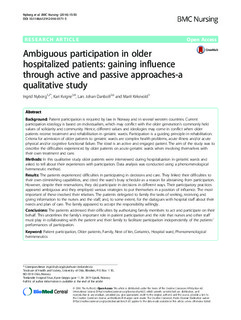Ambiguous participation in older hospitalized patients: gaining influence through active and passive approaches - a qualitative study
Abstract
Background: Patient participation is required by law in Norway and in several western countries. Current participation ideology is based on individualism, which may conflict with the older generation’s commonly held values of solidarity and community. Hence, different values and ideologies may come in conflict when older patients receive treatment and rehabilitation in geriatric wards. Participation is a guiding principle in rehabilitation. Criteria for admission of older patients to geriatric wards are complex health problems, acute illness and/or acute physical and/or cognitive functional failure. The ideal is an active and engaged patient. The aim of the study was to describe the difficulties experienced by older patients on acute geriatric wards when involving themselves with their own treatment and care. Methods: In this qualitative study older patients were interviewed during hospitalization in geriatric wards and asked to tell about their experiences with participation. Data analysis was conducted using a phenomenological hermeneutic method. Results: The patients experienced difficulties in participating in decisions and care. They linked their difficulties to their own diminishing capabilities, and cited the ward’s busy schedule as a reason for abstaining from participation. However, despite their reservations, they did participate in decisions in different ways. Their participatory practices appeared ambiguous and they employed various strategies to put themselves in a position of influence. The most important of these involved their relatives. The patients delegated to family the tasks of seeking, receiving and giving information to the nurses and the staff, and, to some extent, for the dialogues with hospital staff about their needs and plan of care. The family appeared to accept the responsibility willingly. Conclusions: The patients addressed their difficulties by authorizing family members to act and participate on their behalf. This underlines the family’s important role in patient participation and the role that nurses and other staff must play in collaborating with the patient and their family to facilitate participation independently of the patients’ performances of participation.
